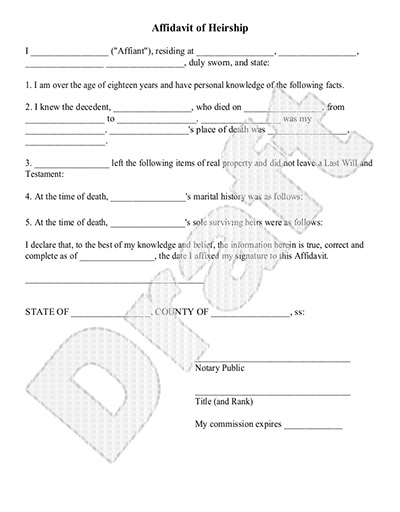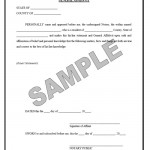This affidavit of heirship form is a legal template that can be used to document ownership of property. An Affidavit of Heirship is used to facilitate the legal transfer of property ownership when the original owner has passed away without a will prepared by a decedent individual.
This affidavit is also often used to help families avoid going through probate hearings by transferring real estate and other property that wasn’t covered by a will. It still has some use even when there is a will.
In most cases property for transfer must not be tied to a debt or any other encumbrance. The person who can file an affidavit of heirship is typically the family such as surviving spouse, adult children, or other close relatives of the deceased. In some cases, a friend or other interested party may also be able to file an affidavit of heirship.
The affidavit of heirship form template must comply with specific rules and instructions in each state. Any and all advice related to this form should be acquired by an attorney and/or someone with working knowledge of your local laws. Most require a notary public and witnesses to validate ownership.
Customize Affidavit of Heirship for Your State
What is an Affidavit of Heirship Form’s purpose?
1. An Affidavit of Heirship is a legal document used to establish the identity and relationship of heirs to a deceased person’s estate.
2. The form is used to establish the legal right of heirs to inherit the deceased person’s assets without the need for probate court proceedings.3. The Affidavit of Heirship must contain certain information about the deceased person and the heirs, including the deceased person’s full name, date of death, and the names, ages, and addresses of the heirs.
4. The Affidavit of Heirship must be signed by two witnesses who are not heirs to the estate. Best witness choices will exclude direct family members altogether.
5. The Affidavit of Heirship must contain signatures of heirs, witnessed and notarized by a notary public.
6. This document is complete once fully prepared, notorized and filed with the county clerk in the county and state where the deceased person resided. Further advice or instructions will be provided by county clerk’s office or courthouse personnel.
7. Your first step will be to locate a legal form specific to your state (such as above), or acquire the assistance of a law firm.





